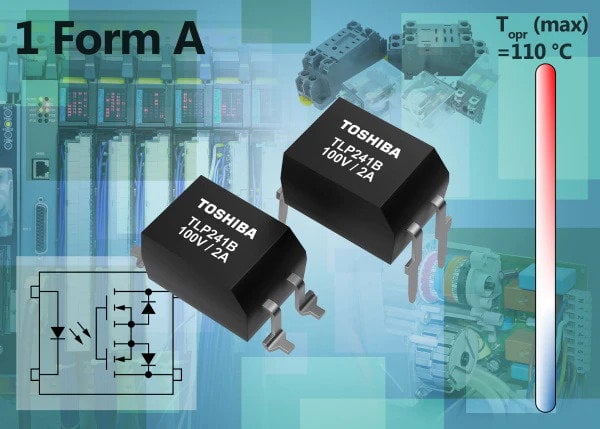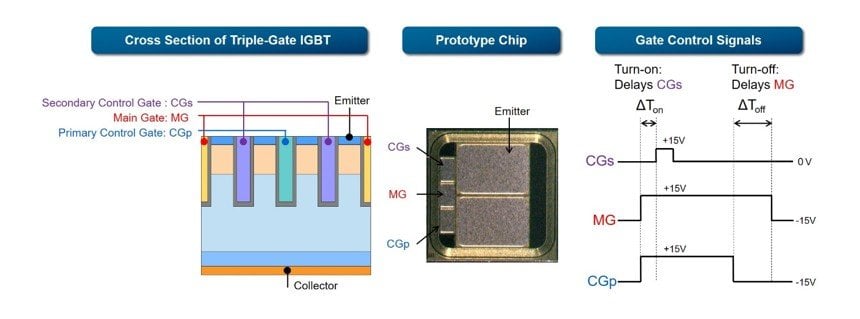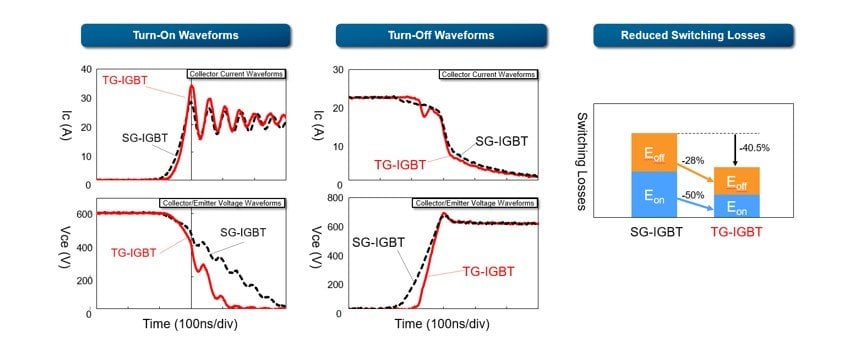electronics-journal.com
03
'21
Written on Modified on
Toshiba’s Triple-Gate IGBT Power Semiconductors Cut Switching Power Losses by 40.5%
Support high efficiency power converters for electrical systems and contribute to the realization of carbon-neutral economy.

Toshiba Corporation (TOKYO: 6502) has developed a prototype triple-gate IGBT*1 that reduces overall power loss by up to 40.5% when switching on and off (switching losses), the process of allowing and stopping electricity flow, in power semiconductors used to control electric power.
It is difficult to reduce power loss in IGBT, due to a trade-off whereby reducing the loss when the IGBT is on (conduction losses) increases switching loss. Toshiba took on this problem by developing a silicon IGBT with a new structure of three gate electrodes and gate control technology that delivers high accuracy gate electrode switching. The new device reduces turn-on loss*2 by 50% and turn-off loss*3 by 28%, an overall reduction of up to 40.5% against a conventional single-gate electrode IGBT, with no increase in conduction losses.
Improving the energy efficiency of power semiconductors is seen as essential for realizing carbon neutrality, particularly by achieving higher efficiency IGBT, power semiconductors used in many products and equipment. The new technology is expected to boost the efficiency of power converters in electrical systems, including renewable energy systems, electric vehicles, railroads, and industrial equipment. Toshiba will present the technology at ISPSD2021, an international online conference from May 30 to June 3.

Triple-Gate IGBT and Gate Control Signals
Power semiconductors that control electric power flows are used in every aspect of power generation, transmission, storage and optimal use, and are crucial for ensuring power supply stability and reducing consumption. In recent years, the power semiconductor market has expanded with the increasing popularity of electric vehicles and the wider use of renewable energy sources, both steps toward the realization of a carbon-neutral economy. In October 2020, the Japanese government set the goal of achieving a carbon neutral Japan by 2050, and initiative like this are is expected to spur further market growth.
These developments are also driving efforts to improve power semiconductor performance, especially of IGBT, high-voltage power semiconductors installed in power converters in a wide range of electrical systems. Improving IGBT energy efficiency will greatly contributes to realizing carbon neutrality.
Conduction losses can be reduced by increasing the number of electrons and holes held on the device, but this increases switching losses. Silicon-based IGBT have been tweaked over the last 30 years by improving the structure to mitigate the trade-off between conduction losses and switching losses, but there have been no breakthroughs in recent years.
Toshiba has developed a triple-gate IGBT and gate control technology that significantly reduces switching loss through flexible control of the accumulation of electrons and holes, from the gate drive circuit side.

Switching Waveforms and Reduction Effects of Switching Losses
The three gates, the main gate (MG), primary control gate (CGp), and secondary control gate (CGs), can be driven independently. When gates are turned on, delaying CGs and first turning on MG and CGp ensures simultaneous large electron and hole flows from the three gate electrodes, and they accumulate in the IGBT at a higher speed, realizing a faster switching time and lower turn-on loss. When turning the gates off, electrons and holes inside the device are reduced by turning off CGp before MG, while leaving CGs off. When the MG is switched off, the IGBT switches off completely and the electrons and holes disappear at high speed, reducing turn-off loss.
By combining triple-gate IGBT with gate control technology, turn-on and turn-off losses have been reduced by 50% and 28%, respectively, compared with conventional IGBT, and overall switching losses have been reduced by up to 40.5%. These technologies realize a significant reduction in the power loss of IGBT, and will greatly contribute to power loss reduction in power converters.
Going forward, the company aims to realize the early commercialization through further research and development of power semiconductors with the new technologies. Furthermore, by improving performance efficiency in various power electronic devices with these technologies, the company will contribute to the realization of carbon neutral economy.
www.toshiba.com

